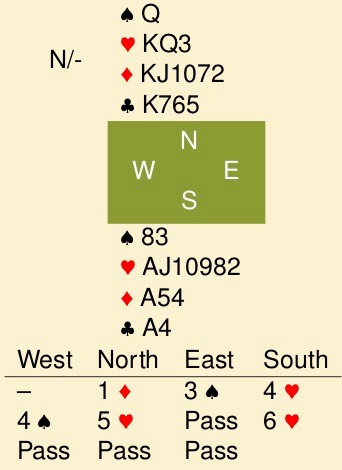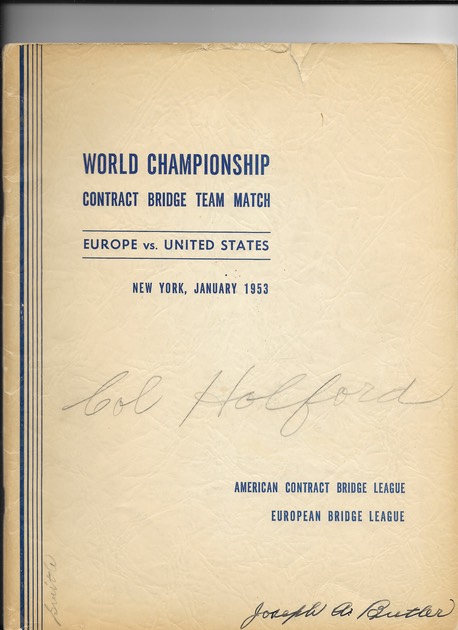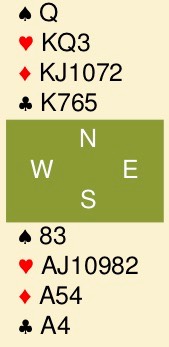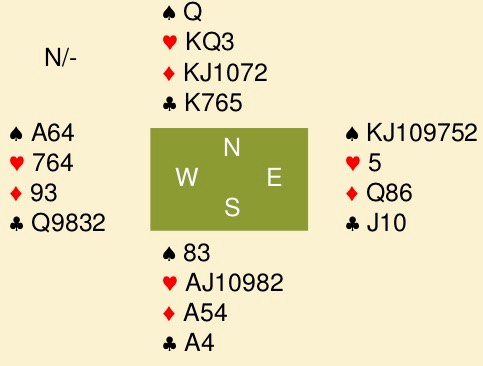
For starters, a play problem. You are in 6♥ on a hand where, in particular, partner did a lot of bidding for his values. Nevertheless, the final contract is reasonable, all it requires is that you pick up the diamonds for 3 tricks. There are 2 ways to do that (♦A and small to the ♦10, or ♦K and run the ♦10), with the former winning if west has the ♦Q and the latter if she is with east. West led the ♠A and continued with a trump, both sides following. With east having lots of spades, it figures that west must have a couple of diamonds. So, simply draw trumps and take a diamond finesse through west? Or can we do better?
Shocked. The local bridge communitiy here was shocked to hear that two local experts passed away over the last week. First Piet van Zutphen (full obituary here), then a couple of days later Frank Willemsen. At the time of writing this blog, no obituary or funeral details are available. I’ve played a lot of hands against them over the past 15 years that I’ve lived in this area, and, while I’m sure that both of you are in a better place now, I’ll miss those encounters at the table.
Less of a shock. The Italian Federal Court declared the last verdict in the Fantoni-Nunes case final. The summary of the verdict is available here, a longer version with the motivation will be published later. I’ve written about this before, click here and here. Actually, the latest decision doesn’t suprise me at all, by the time the case entered the courtrooms, it was no longer about bridge but about process. And, while there seems to be general consensus that FN used illegal signals, the process to prosecute them and turn evidence into a conviction (or not, if they didn’t) was flawed at all stages. Let’s hope that the powers that be have learned from this, and other, failed cases and review the process. I’m not holding my breath though.

And some good news as well. I finally found a copy of the 1953 (first) book in the series of Bermuda Bowl (World Championship) Books. It is currently in the mail, when it arrives, there will be a blog about it. 1953 was in fact the third Bermuda Bowl ever played, but no books were written about the first 2 events (1950 and 1951). There was no Bermuda Bowl at all in 1953. With another new arrival, the 2017 book, that means that my collection is now complete, some 40 years after I bought the first one (the 1980 one, on the Valkenburg Olympiad).
Back to the hand. The standard approach to this problem is called “vacant places”. What you do, is take the number of known cards in both hands and substract that from 13 (or whatever number of cards both players have left). What is left, is the number of places where an unknown card can be, or vacant places. Finally, play for that card in the hand with the larger number of vacant places.

Time to look at the hand after trick 2. ♠A led, trump to your hand with both sides following. The auction suggest that east has 7♠ and we have seen him follow to a round of trumps. That meant that he started 5 other cards. West started with 3♠ and also a trump, leaving room for 9 other cards. Those slots are called vacant places and the ♦Q must occupy one of those 14 vacant places.
Which of the 14? We don’t know, but it is obviously more likely that it will be in the hand with 9 vacant places rather than 5. So, at this point, playing west for the ♦Q is a 9 to 5 favorite.
But wait, we don’t have to make this decision now. We have to ruff our spade loser and draw trumps at some point, so let’s do that first. If you do so, you’ll find that west had 3 trumps and east 1 (and no, he wasn’t helpful to discard a diamond or signal something useful). Does that change anything?
Well, not much, west is now known to have 3 spades and 3 hearts, for a total of 6, or 7 vacant places. East has 8 known cards, or 5 vacant places. That still makes west a 7 to 5 favorite to hold the ♦Q.
But there is something else we can do: play the ♣AK and ruff a club. East shows out on third club (discarding an other useless spade). But this changes the odds significantly. East is now known to have started with 7 spades, 1 heart and 2 clubs, thus 3 diamonds. West had 3 spades, 3 hearts, 5 clubs and thus only 2 diamonds.
Suddenly the odds have flipped, with east becoming a 3 to 2 favorite to hold the ♦Q.

At our table, declarer played a diamond to the ♦K and ran the ♦10. Right he was. This looks quite simple once you think about this, but the point was missed at 6 other tables. The full hand was this.
Note that all this doesn’t change significantly if you think east overcalled on a 6 or 8 card suit.
